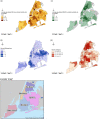Impact of hepatitis B on mortality and specific causes of death in adults with and without HIV co-infection in NYC, 2000-2011
- PMID: 27510414
- PMCID: PMC9150190
- DOI: 10.1017/S0950268816001801
Impact of hepatitis B on mortality and specific causes of death in adults with and without HIV co-infection in NYC, 2000-2011
Abstract
High rates of immigration from endemic countries contribute to the high chronic hepatitis B (HBV) prevalence in New York City (NYC) compared to the United States overall, i.e. about 1 million individuals. We describe the impact of HBV infection on mortality and specific causes of death in NYC. We matched surveillance and vital statistics mortality data collected from 2000 to 2011 by the New York City Department of Health and Mental Hygiene (DOHMH) and analysed demographics and premature deaths (i.e. whether death occurred at <65 years) in persons with and without chronic HBV or HIV infection (excluding those with hepatitis C). From 2000 to 2011, a total of 588 346 adults died in NYC. Of all decedents, 568 753 (97%) had no report of HIV or HBV, and 4346 (0·7%) had an HBV report. Of HBV-infected decedents, 1074 (25%) were HIV co-infected. Fifty-five percent of HBV mono-infected and 95% of HBV/HIV co-infected decedents died prematurely. HBV disproportionately impacts two subgroups: Chinese immigrants and HIV-infected individuals. These two subgroups are geographically clustered in different neighbourhoods of NYC. Tailoring prevention and treatment messages to each group is necessary to reduce the overall burden of HBV in NYC.
Keywords: HIV/AIDS; Hepatitis B; mortality; surveillance.
Figures


References
-
- NYC DOHMH. Hepatitis B and C surveillance report: New York City 2013. New York, NY: New York City Department of Health and Mental Hygiene, Division of Disease Control, Bureau of Communicable Diseases, 2015.
-
- WHO. Guidelines for the prevention, care and treatment of persons with chronic hepatitis B infection. Geneva, Switzerland, 2015. - PubMed
-
- CDC. Surveillance of viral hepatitis – United States, 2013. United States: Centers for Disease Control and Prevention, Hepatitis DoV, 20 July 2013, 2015 (http://www.cdc.gov/hepatitis/statistics/2013surveillance/pdfs/2013hepsur...).
-
- Stasi C, et al. The epidemiological changes of HCV and HBV infections in the era of new antiviral therapies and the anti-HBV vaccine. Journal of Infection and Public Health 2016; 9: 389–395. - PubMed
LinkOut - more resources
Full Text Sources
Other Literature Sources

